University of Michigan Formula SAE Racing Team – Featured Customer
Featured Image Courtesy of University of Michigan Formula SAE Racing Team
Formula SAE is a student design competition that began in 1980. The competition was founded by the SAE (Society of Automotive Engineers) branch at the University of Texas. Each year, hundreds of universities across the world spend months designing and manufacturing their best Formula style car before putting them to the test in competitions.
Alex Marshalek is the Team Captain of the University of Michigan’s Formula SAE team, MRacing. The team was originally founded in 1986, and has been very successful over the years. In the 2017 season, they finished 5th at the Formula SAE Michigan event, and took home a 1st place finish at Formula North. They are hoping to continue riding that momentum into another successful season in 2018.

Photo Courtesy of: University of Michigan Formula SAE Racing Team
Alex reached out to Harvey Tool and Helical earlier this year, and after some conversation, the decision was made to sponsor their team’s efforts by supplying cutting tools and providing technical support. With competitions on the horizon and a new build coming over the summer, Alex was kind enough to find some time to talk with us about his experiences as a student learning the ropes in engineering, manufacturing, and design, the importance of quality tooling and maintaining a superior part finish for competition, and challenges he has faced during this process.
Hi Alex. Thanks for taking the time to talk with us today. When you were looking into college degree programs, what initially interested you in manufacturing and engineering?
I have always had an interest in Aerospace Engineering, but it was nothing more than a personal interest until I started college. My high school unfortunately did not have any machine shop or manufacturing type classes, so a lot of what I knew, I learned from my dad. My dad worked as a Mechanical Engineer at an axle manufacturing company, and he used to always be doing things around the house and showing me the basics of engineering and design.
When it came time to choose a school, I knew that Michigan had an impressive Aerospace Engineering department, and I liked the feel of the campus and community better than other schools I had toured.
How did you first get involved with the Formula SAE team?
I knew going into school that I wanted to get involved in a design team and advance my learning in that way. We have about a dozen different design teams at Michigan, but the Formula SAE team really stood out to me as a really cool project to get involved in.
I started with the team in Fall of 2016, helping out with the design and manufacturing of the vehicle’s suspension. Now, for the upcoming 2018 season, I am taking over the role of Team Captain. There will be a little bit less hands-on design and manufacturing work for me as it is more of an administrative/outreach role.
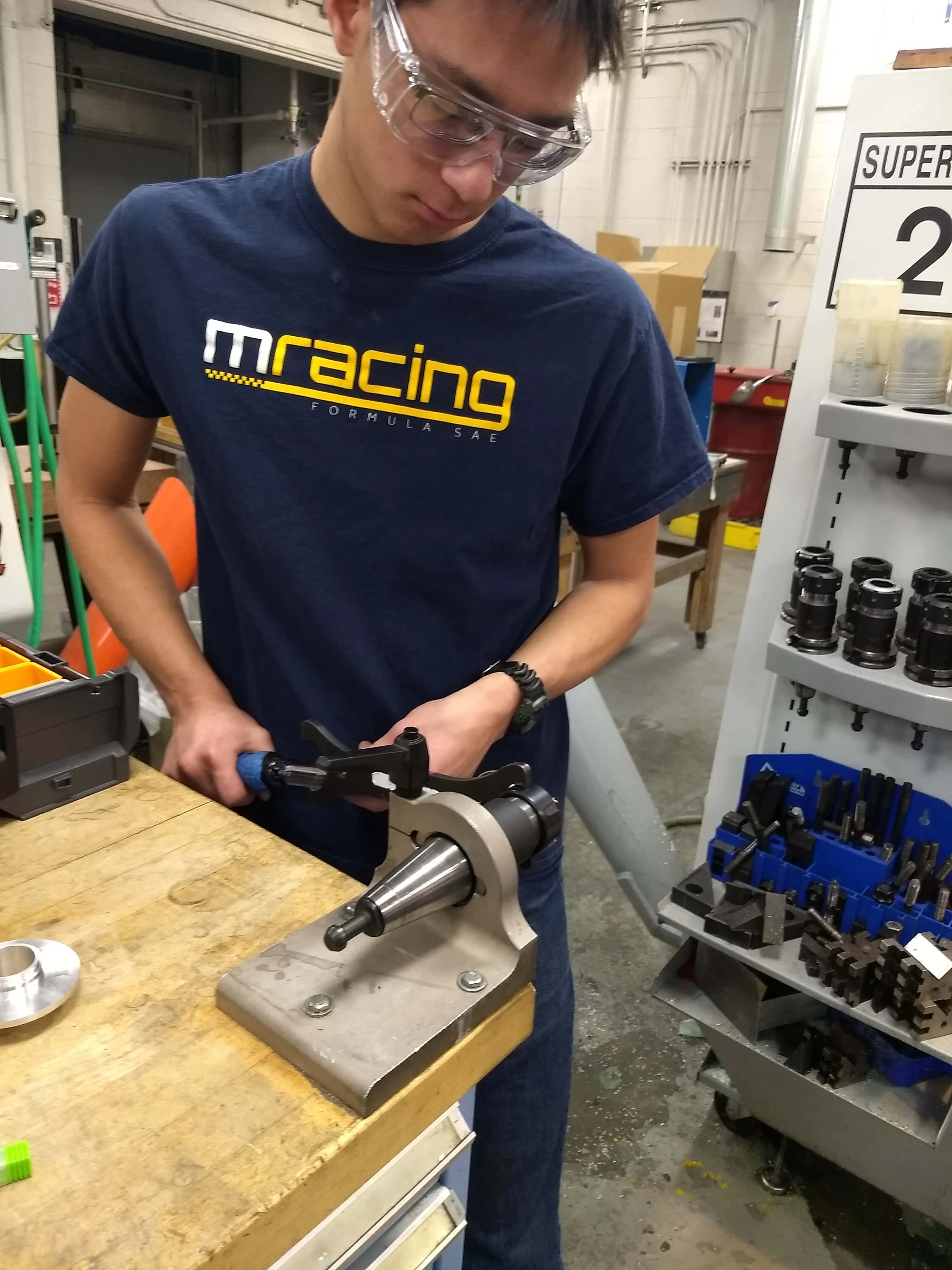
Photo Courtesy of: University of Michigan Formula SAE Racing Team
How does a typical FSAE season run?
So FSAE seasons are constantly running, and nearly overlapping with each other. For example, we are currently finishing up competitions from the 2018 season, but at the same time we are beginning the design of the vehicle for the 2019 season. Typically, the design work is done over the summer, and finalized in October. After that, the major manufacturing begins and lasts until about March, with spare parts and additions being added as we go. Testing begins in March, where we fine tune the vehicle and optimize the design for performance. Then, the rest of the Spring and early Summer is competition time, and the process starts all over again!
What sort of machines do you have in the shop?
Right now, we have three manual Bridgeport mills, two retro-fit CNC Bridgeport mills, 2 manual lathes, 1 retro-fit CNC lathe, and a Haas VF-2SS and Haas SL-20. For the vast majority of what we are machining, we are using the Haas. We do most of our work in Aluminum, with some parts made out of steel or titanium, and the Haas has been great for everything.
We are also using AutoDesk’s Fusion 360 software for our CAD/CAM, and we love it.
What has been the most difficult part of the build?
Time is really the biggest challenge. We are all full-time students, so time is already hard to find, but we also don’t have an overabundance of machinists so the operators can get overburdened. It all works out in the end and our machinists are great, but time management is truly the biggest challenge.

Photo Courtesy of: University of Michigan Formula SAE Racing Team
The composite materials we work with are also very challenging to machine. We constructed the vehicle’s monocoque (the structural “skin”, often seen in Formula One cars) out of carbon fiber. While we cut a lot of it on the water jet machine, we needed more precise holes than a water jet could offer, so we went to the Haas for that. We were using HSS drills and only getting 10-12 holes at a time before they wore out. However, we had Don Grandt (Harvey Performance Company Application Engineer) stop in the shop and he sent us a few Harvey Tool diamond coated drills, which should make this a much faster and more precise process!
You mentioned Don stopped in to give you guys a visit. What were some of your biggest takeaways?
Don was great. He stopped by and we gave him a tour of the facility and showed off some of the parts we were designing. We talked shop for quite a bit, and he gave us a bunch of great tips and tricks we could use to really optimize our machining. As I mentioned, he also went through the catalogs with us and helped us find exactly what we need for tooling. The Harvey Tool diamond coated drills are going to be a life saver for carbon fiber. I guess the biggest takeaway was just all of the knowledge we received from Don and how helpful that was to have someone direct from the tooling manufacturer sharing everything we knew with us.
Now that you have the Harvey and Helical tools in the shop, how have they helped you complete this project and get a leg up on your competition?
One of the most impressive things for us have been the finishing end mills we received. The Helical finishers for Aluminum are giving us some of the best finishes we have ever seen. For us, that is a point of pride. We not only want to have the fastest and most well-designed vehicle, but we also want to have the best looking parts. Subpar finishes reflect poorly on the entire build, and first impressions mean a lot in these competitions.
We have also been blown away by the Chipbreaker roughers. We absolutely love those tools and push them to the limits with great results. In fact, the first time we ran them, we used Machining Advisor Pro to dial in our speeds and feeds, and the numbers seemed insane to us. We were nervous, but we pushed the button and let it run. It was amazing to see that we could push a tool that fast without tool failure.
How has your experience been using Machining Advisor Pro?
We use Machining Advisor Pro every time we picked up the Helical end mills. MAP was actually one of the main reasons we were looking for Helical to sponsor us. We had heard a lot about MAP and your level of technical support, which was important to us as we are learning more about manufacturing and machining. Machining Advisor Pro has quickly become one of our best learning tools in the shop.
The nice thing about MAP is that is takes a look at all of the parameters. A lot of applications only give you numbers on your speeds and feeds, but MAP takes a look at the depth of cut, chip thinning, engagement angle, and all of the other parameters that are so essential to a successful run. As a result, we have been able to get very aggressive with the end mills. We are not a huge production shop, so cycle times are not as important, but we still want to get the most out of our tools in the least amount of possible time.
So, let’s break down some specs. What are you all working with on this year’s build?
Right now our car features a 4 cylinder Honda 600 CBR engine, with a Turbo and 600cc displacement. We are one of the few teams that run a turbo in competition. As we mentioned, the monocoque is completely carbon fiber, and the car features a full aero package with an undertray. The max speed is around 80 MPH, and the car weighs 420 pounds without the driver.
Once the build is complete, how does a typical competition work?
Most of the Formula SAE competitions are multi-day events, with a few static events, and then dynamic events where the car is running. For static events, we first have a Design portion. We validate and argue for our design in front of judges who are engineers in the industry. Then, we get into a Cost presentation, as one of the goals is to build the cheapest possible car with a high level of performance. That balance of cost vs. performance is a critical part of the build. The last static event is a Business presentation, where we introduce a business/manufacturing plan on how to get this design to a production level of 100 units in a year.
For the dynamic events, we have 4 different tests. First, we have the Accel Run, which is a 75 meter sprint, and the fastest cars win. From there we go to the Skip Pad event, which is centered on turning radius and the stiffness of the chassis as we do tight figure eight turns with the car.
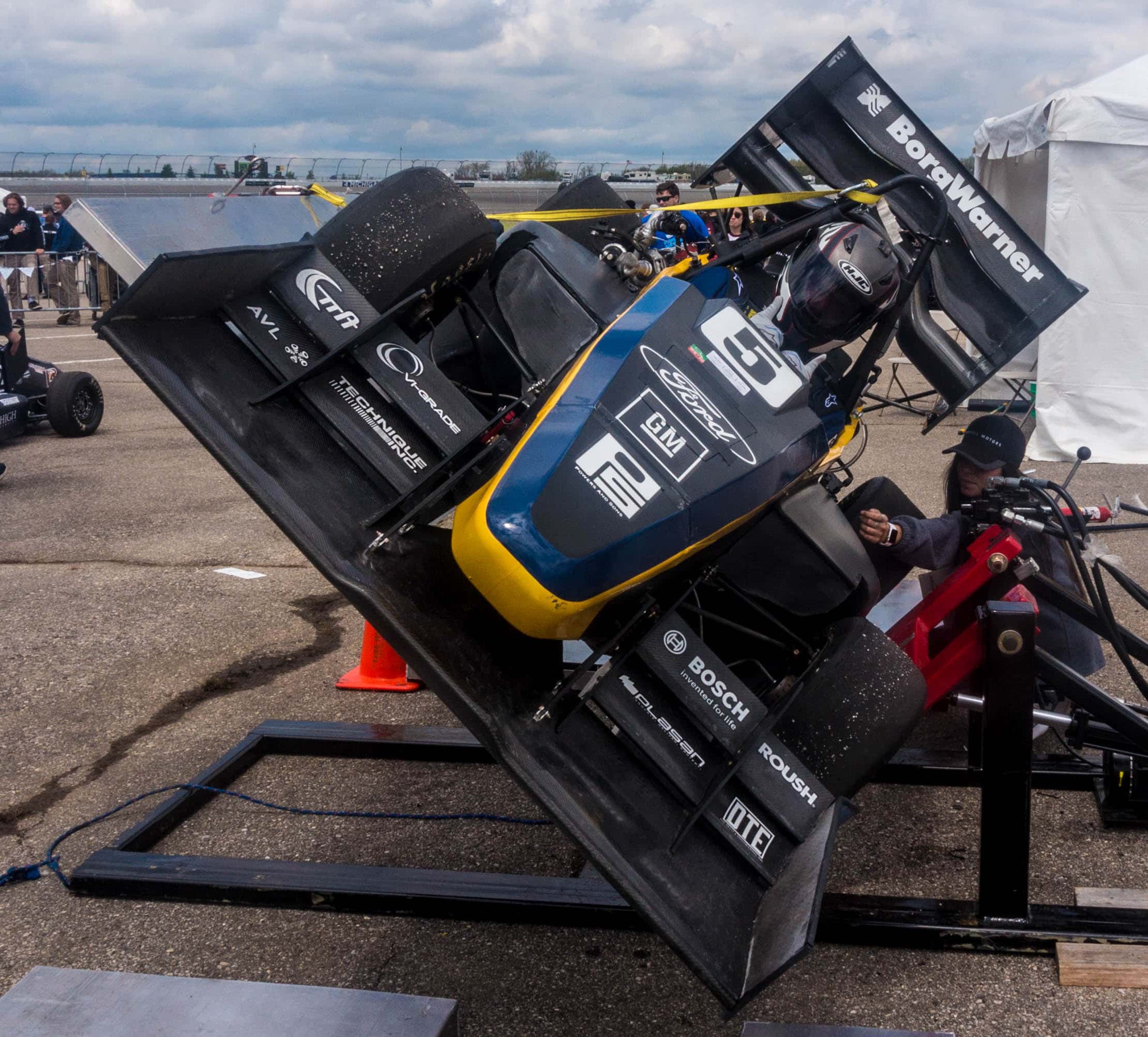
Photo Courtesy of: University of Michigan Formula SAE Racing Team
Then we have the AutoCross, a one lap race, which determines our placement in the final event; Endurance. For the Endurance event, we drive the cars around a 22km track, and the goal is to finish the race without any mechanical or design failures in the quickest time possible. Only around 50% of participants actually complete this event. If a single part falls off, or breaks, you are disqualified. Many times we see things like the suspension, powertrain, or wings falling off. It is disappointing when it happens, but it allows us to easily identify any flaws and fix them for the next event.
What is next for you after school? Any future plans or goals?
I am currently majoring in Aerospace Engineering, and would like to stay within that industry. I am leaning towards working on aircraft. Designing either aircraft structures or the aerodynamics would be very cool. I really like the size and scale of working on commercial aircraft, but I could see myself doing something more specialty like working in Defense as well.
Alex and his team had a very successful 2018 season. They recently placed 9th overall in a competition at the Michigan International Speedway. In the dynamic events, they placed 4th in Skidpad, and 7th in Autocross. The high placement in the Autocross event allowed them to race head to head against top teams in the world, and they ended up placing 4th in Endurance out of 104 cars!
The MRacing team also competed at Formula North, a competition in Ontario, Canada, where they achieved a top ranking of 2nd place overall. They passed all of the technical inspections on the first try and placed 1st in Acceleration, 2nd in Skidpad and Endurance, 3rd in Autocross, and 4th in Efficiency.

Photo Courtesy of: University of Michigan Formula SAE Racing Team
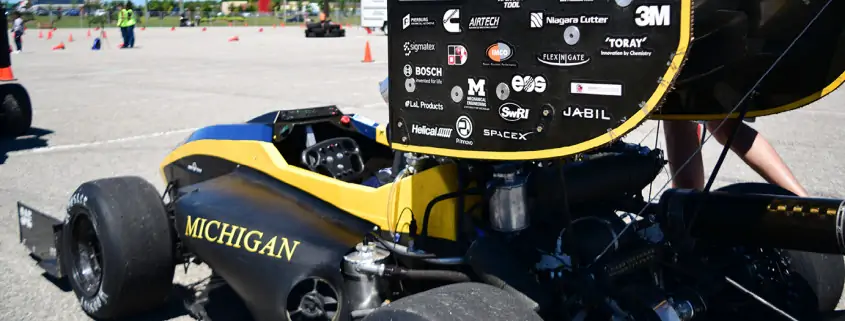

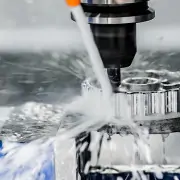

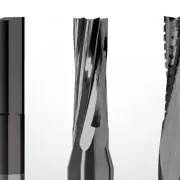
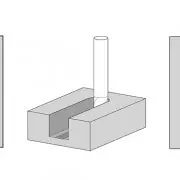
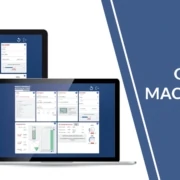

Leave a Reply
Want to join the discussion?Feel free to contribute!